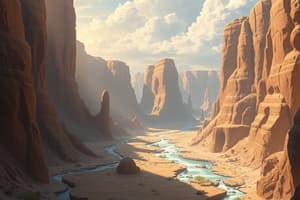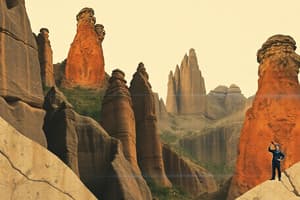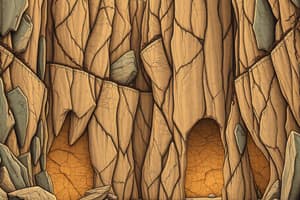Podcast
Questions and Answers
A geologist is examining a sequence of sedimentary rocks. They observe that a fault cuts through several layers, but does not extend into the overlying, youngest layer. What principle of relative dating BEST applies to this observation?
A geologist is examining a sequence of sedimentary rocks. They observe that a fault cuts through several layers, but does not extend into the overlying, youngest layer. What principle of relative dating BEST applies to this observation?
- Cross-cutting relationships (correct)
- Superposition
- Original horizontality
- Lateral continuity
Which concept suggests that geological processes operating today are similar to those that have operated throughout Earth's history?
Which concept suggests that geological processes operating today are similar to those that have operated throughout Earth's history?
- Gradualism
- Uniformitarianism (correct)
- Catastrophism
- Punctuated equilibrium
Imagine a geological formation where horizontal sedimentary layers are found beneath tilted sedimentary layers. What type of unconformity is present?
Imagine a geological formation where horizontal sedimentary layers are found beneath tilted sedimentary layers. What type of unconformity is present?
- Conformity
- Disconformity
- Nonconformity
- Angular unconformity (correct)
In a sequence of undisturbed sedimentary rocks, where are the oldest rocks typically located?
In a sequence of undisturbed sedimentary rocks, where are the oldest rocks typically located?
Why is having repeatable observations crucial for an endeavor to be considered scientific?
Why is having repeatable observations crucial for an endeavor to be considered scientific?
In a cross-section of rock layers, what principle is most important to apply when determining the relative sequence of geological events?
In a cross-section of rock layers, what principle is most important to apply when determining the relative sequence of geological events?
The original geologic time scale was primarily developed using which type of dating method?
The original geologic time scale was primarily developed using which type of dating method?
What geological process best describes correlation?
What geological process best describes correlation?
Fossil succession is a fundamental principle in which area of study?
Fossil succession is a fundamental principle in which area of study?
Which property of a mineral is least reliable when identifying a mineral sample and why?
Which property of a mineral is least reliable when identifying a mineral sample and why?
Why are zircons particularly useful for radiometric dating of very old rocks?
Why are zircons particularly useful for radiometric dating of very old rocks?
A geologist finds an igneous rock with large, visible crystals. Which term describes this rock's texture?
A geologist finds an igneous rock with large, visible crystals. Which term describes this rock's texture?
Which of the following statements accurately describes the difference between magma and lava?
Which of the following statements accurately describes the difference between magma and lava?
Flashcards
Historical Geology
Historical Geology
The study of the Earth's origin and its development through time, focusing on the record of past events.
Hypothesis
Hypothesis
An idea or proposition that hasn't been proven true or false yet.
Superposition
Superposition
States that in undisturbed rock sequences, the oldest layers are at the bottom, and the youngest are at the top.
Lateral Continuity
Lateral Continuity
Signup and view all the flashcards
Uniformitarianism
Uniformitarianism
Signup and view all the flashcards
Cross-Section Sequencing
Cross-Section Sequencing
Signup and view all the flashcards
Relative Dating
Relative Dating
Signup and view all the flashcards
Correlation
Correlation
Signup and view all the flashcards
Fossil Succession
Fossil Succession
Signup and view all the flashcards
Half-life
Half-life
Signup and view all the flashcards
Mineral
Mineral
Signup and view all the flashcards
Magma vs. Lava
Magma vs. Lava
Signup and view all the flashcards
Sediment
Sediment
Signup and view all the flashcards
Study Notes
- The exam covers 50 multiple-choice questions, focusing on historical geology, geologic time principles, measuring deep time, and the rock cycle.
Module 1 – What is Historical Geology?
- Historical geology studies Earth's origin and development through time, using the record of past events.
- Paleontology involves studying molecular fossils.
- A hypothesis is an idea or proposition whose truth or falsehood is not initially known.
- Scientific endeavors need to have repeatable observations.
- Earth is approximately 4.56 billion years old.
- The Universe is approximately 13.7 billion years old.
Module 2 – Principles of Geologic Time
- Geology principles include superposition.
- Geology principles include Lateral continuity.
- Geology principles include Original horizontality.
- Geology principles include Cross-cutting relationships.
- Geology principles include Fossil succession.
- Need differentiate between relative and numerical ages.
- Uniformitarianism means "the present is the key to the past".
- There are three types of unconformities: disconformity, nonconformity, and angular unconformity.
- Need to recognize unconformities in diagram form.
- Recognize which unconformity represents the most missing time.
- Cross-sections are used to determine the sequence of events.
Module 3 – Measuring Deep Time
- The geologic time scale was first developed using relative dating methods.
- Correlation is linking rock formations from different places over a long distance.
- Fossil succession is biostratigraphy.
- William Smith created the first geologic map of Great Britain.
- Eras are split into periods, which are then split into epochs of time.
- Atoms consist of orbiting electrons and a nucleus (protons and neutrons).
- Half-life is the time required for one half of a population of parent atoms to decay.
- Zircons are used to age date extremely old rocks.
Module 4 – The Rock Cycle
- Minerals must meet five criteria, beginning with being naturally occurring.
- Minerals must be inorganic.
- Minerals must be solids.
- Minerals must have a defined crystalline structure.
- Minerals must have a definite chemical composition.
- Observations to determine a mineral's identity include color, luster, and cleavage/fracture.
- You should know how to identify quartz, pyrite, calcite, halite, and feldspar.
- Be aware of which minerals will react to acid.
- The strongest chemical bond is covalent.
- The most abundant elements in the Earth's crust (in order) are O, Si, Al, Fe, Ca, Na, K, and Mg.
- The building block of all silicate minerals is the silica tetrahedron.
- Silicates make up more than 90% of Earth's crust.
- Magma is deep in the crust, while lava reaches the surface of the Earth.
- Igneous rock textures include Phaneritic and Aphanitic.
- Igneous rock compositions include Felsic, Intermediate, and Mafic.
- There are connections between types of minerals in the rock names and how much silica content.
- Example: Granite and Basalt.
- A sediment consists of loose fragments of rocks or minerals, shells/fragments, or mineral crystals that precipitate out of water.
- Lithification is the process in which sediment becomes compacted and cemented.
- A metamorphic rock is a rock that has undergone change.
- A protolith is the "parent rock" that undergoes changes in texture and mineral content.
- Example: Limestone turns into Marble.
Studying That Suits You
Use AI to generate personalized quizzes and flashcards to suit your learning preferences.




